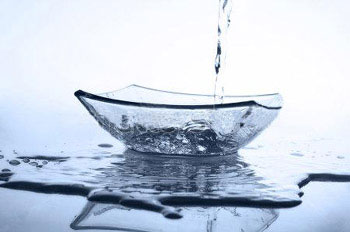
When a molecule comes out of the liquid surface, it has to oppose the attraction of the surface molecules it is leaving behind. This needs extra energy. Thus, only those molecules, which have kinetic energy sufficiently larger than the average, can escape. The average kinetic energy of the remaining liquid decreases and hence, its temperature goes down. Thus evaporation promotes cooling process.
The cooling effect of evaporation is strikingly evident when 'rubbing alcohol' is poured on your back. The alcohol evaporates very rapidly, cooling the surface of the body quickly. The more rapid the evaporation is, the faster the cooling. When our bodies overheat, our sweat glands produce perspiration. This is part of nature's thermostat, for the evaporation of perspiration cools us and helps us maintain a stable body temperature. Many animals do not have sweat glands and must cool themselves by other means.
The rate of evaporation is greater at higher temperatures because there are a greater proportion of molecules having sufficient kinetic energy to escape the liquid. Water evaporates at lower temperatures, too, but at a lower rate. A puddle of water, for example, may evaporate to dryness on a cool day.
This effect is used in cooling water in earthen pots in summer. The porous surface evaporates the water taking heat from the water body, resulting in cooling of the water.

There is a difference between the process of evaporation and the process of boiling. In evaporation, the liquid molecules escape the liquid surface without any external heat source. The process by which liquid changes to gaseous state is known as evaporation.
Consider two molecules in a liquid. Molecule-1 is at the surface and another molecule-2 is deep inside the liquid. The molecule-2 experiences attractive cohesive forces from molecules surrounding it. The molecule-1 on the surface feels forces of attraction or cohesive forces from the molecules only on one side. The other side it is exposed to air. The force of cohesion in the case of molecule-1 is less when compared to the cohesive forces experienced by molecule-2.
We know that the molecules are never at rest. They can have slight translational and vibrational motions about their mean positions. They thus possess some amount of kinetic energy. Sometimes the molecules collide with each other and exchange their kinetic energies. Thus at any given time, the kinetic energy of a few molecules may become quite large and they can escape from the surface. The probability of escape from the surface is larger for molecule-1, as its cohesive force holding it back to the liquid is less than that experienced by molecule-2. This is how evaporation takes place.
If you keep water in a saucer and expose it to air, you will see the water disappearing after sometime. The water is converted into gaseous state without giving it an extra energy or heating it up to its boiling point.


Observations on evaporation
From the microscopic explanation given above, all the observations regarding the phenomena of evaporation can be explained clearly.
- The number of molecules on a larger surface will be more than those on a smaller surface. Since evaporation takes place due to molecules escaping from the liquid surface, it is obvious that the rate of evaporation will be faster from a vessel with a larger mouth.
- The higher temperature of a liquid means higher molecular kinetic energy. Hence the rate of evaporation is larger for a liquid at higher temperatures.
- The nature of the attractive cohesive forces will determine the rate of evaporation. The cohesive force in water is much larger than that in alcohol. This is the reason why the rate of evaporation in alcohol is higher than that seen in water.
The high concentrations of salts in the dead sea make it a good source of
bromine and a number of other chemicals.
- The rate of evaporation in a closed vessel is slower than that in the open vessel. The molecules escaping from the surface of the liquid in a closed vessel collect in the space above the liquid. Some of the molecules evaporated can return and condense back to the liquid, after losing their energy in collision. Thus the evaporation-condensation goes on till equilibrium is reached. That is, the rate of molecules evaporating is the same as the rate of molecules condensing back. Once the equilibrium is established, no more extra evaporation occurs. (In this situation, the space above the liquid is said to be saturated with vapor. The pressure exerted by the vapor on the liquid is said to be saturated vapor pressure. The saturated vapor pressure of a liquid increases with the increase of temperature).
- But the same phenomena does not happen in an open vessel. Because molecules escaping from its surface get scattered away into the atmosphere, they are unable to condense back in the same liquid surface. New molecules come to the surface, get evaporated and the process continues.
Put some drops of water in your hand. When the water evaporates, you feel cool. The heat required by the water molecules is taken from your skin itself. The temperature of the surrounding skin is lowered a bit. This makes you feel cool.
We now know that energetic molecules escape from the surface of a liquid during evaporation. This lowers the average kinetic energy of the molecules left behind in the liquid and in turn the temperature of the liquid. This is the reason why you put tea/coffee in a saucer to cool it. Blowing also cools a hot liquid, because it makes the energetic molecules leave the surface quickly.